I’m very excited about the HERO COMPLEX film festival this weekend! They will show DICK TRACY with Warren Beatty, SUPERMAN I and II (The Donner Cut) with Richard Donner, THE INCREDIBLES with supervising animator Dave Mullins, IRON MAN 1 & 2 with Jon Favreau, the STAR TREK II: THE WRATH OF KHAN with Nicolas Meyer, and STAR TREK (2009) with Orci, Kurtzman, and Lindelof. So in preparation, I thought I’d write about something I’ve been meaning to cover for a long time: the science of STAR TREK!
Since there might be people coming to this article who don’t know me, my real job is a staff astronomer at Las Cumbres Observatory and faculty at UC Santa Barbara. The main focus of my research is supernovae. I’m also a host of the series KNOWN UNIVERSE on NatGeo.
Since this always comes up, let me reiterate the premise I’ve followed for all of these articles, whether they are about THOR, GREEN LANTERN, or AVATAR. If you need to bend some of the known laws of physics to tell a good story, that’s fine. I’m very happy with the Enterprise going faster than light. But if you get the fundamentals of how the universe works wrong just because you are lazy or sloppy it really takes me out of the movie. Who do you respect more, Stanley Kubrick, whose details enrich his films and elevate the viewer to a higher metaphysical state of being, or Michael Bay, whose disdain for even a fig leaf of plausibility actually causes devolution in audiences?
In this article, I’m just going to cover the 2009 J. J. Abrams STAR TREK reboot. If you’d like a more detailed look at some of the broader questions in the Trek concept or history, I recommend Lawrence Krauss’ excellent book, THE PHYSICS OF STAR TREK. For example, do the transporters work by beaming your actual matter or just the information about your atoms and their positions? Depending on the particular need in the plot, the show has treated it both ways. Since you can’t revive characters by restoring them from their last beaming, that implies that you need the atoms. On the other hand, the episode with two Rikers implies all you need is the information. But the physics implications, and energy requirements, are quite different – they differ by a factor of the speed of light squared. The point isn’t to be pedantic, it is to have some fun while thinking deep thoughts and pondering the ways of the universe.
STAR TREK (2009)
I’m a pretty big Trek fan. But after a while the shows and films just became formulaic. Or, more precisely, the formula from the old series just wore thin after a few decades. And with each new series they would not so much invent new characters as copy characters that worked previously: honorable commander, nonhuman outsider, inexperienced youngster, folksy human, sexy vixen, and crew member from a once-enemy species. Things got so predictable that they even lost a giant space geek like me.
That’s why I was happy to hear they were putting a stop to the endless string of sometimes wayward copies and going right back to the characters that inspired it all. The franchise was in desperate need of someone who wouldn’t play it safe, and they hit the jackpot with J. J. Abrams. He and the team behind this Trek did a stellar job. There was great action, it was true to the characters, and it was funny and exciting too. I understand it wasn’t for everyone, but every time I hear a rant about how different it is, I think of this Onion clip: Trekkies bash new Star Trek film as fun, watchable.
But there is one thing that this Trek mangled pretty badly: the science. In fact, they got things so wrong that it ruined some of my colleagues’ enjoyment of the film. I still enjoyed it, but there are times when I want to throw something at the screen. By now I hope everyone who wants to see the film already has. So I won’t summarize the plot, I’ll just get right into the science.
THE COSMIC COINCIDENCE
The fun really begins when Kirk is forcibly marooned on a planet near Vulcan. He calls it Delta Vega, but it is certainly not the Delta Vega from the original series.
He’s got a whole planet that he could have set down on (big enough to have Earth gravity), yet he is barely there a minute before he runs into his bestest bud in the universe!
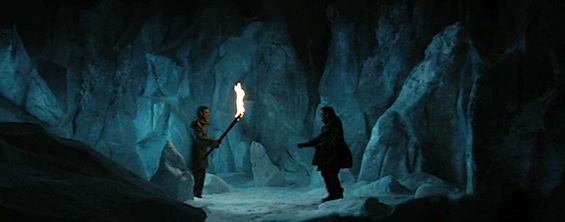
Now you can take this improbability and square it, because a few minutes later they run into Montgomery Scott. Relying on coincidence to drive the plot is just sloppy writing. That is barely science, but it bugs the hell out of me.
Would it have killed them to have thrown in an exchange like:
KIRK: “What are the odds of meeting you here!”
ELDER SPOCK: “Unity. The only continent on this moon is 20 square kilometers.”
But what really bugs me is something else. In a mind meld, Spock reveals that he watched the destruction of Vulcan from this planet. Apparently, they were going to have him see this through a telescope, but decided it would be more cinematic if he just looked up and saw it with his naked eye.
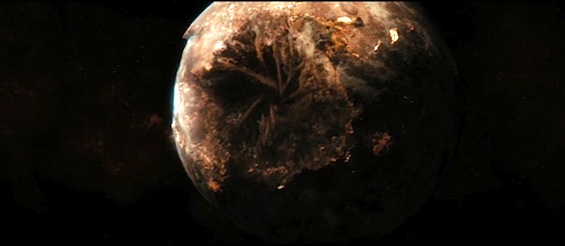
I actually agree with that decision – it makes a great spectacle to witness the destruction of another planet from the surface of a planetoid. But the problem is that for Vulcan to loom that large in the sky, larger than our moon, Delta Vega could not be a separate planet. It would have to be a moon of Vulcan. You can calculate how far away it is by its angular size: d=206265 * D / X, where D is the linear diameter Vulcan, and X is the angle it subtends in arcseconds. If Vulcan is about the same size as Earth (it basically has to be because it has similar gravity), and the angular size of Vulcan as seen from Delta Vega is about two degrees (a guestimate based on the fact that our moon subtends half a degree), then Delta Vega is about as far as the Moon is from Earth. Anything that close would become gravitationally bound. So regardless of what other background sources say, I’m going to treat Delta Vega as a moon of Vulcan.
Technically if they are of comparable size it really should be considered a binary planet. I’d have made it smaller (a true moon), and made the Kirk escaping the monster scene more fun by having him still adjusting to the low gravity on that moon. I’ve actually had to run on a reduced gravity machine for KNOWN UNIVERSE – it is strange and crazy.
Incidentally, I thought the destruction of Vulcan looked very cool. It was a little faster than it would have been physically, but that’s just dramatic license. The crumbling of the planet would have been a pressure wave, so it is limited by the sound speed through the planet. This is basically the speed of P-waves in earthquakes, about 8 kilometers per second. Even Twitter is faster than earthquakes. It should have taken about half an hour to destroy the planet. They can’t take the time to show that in a film, but it is fun that we can calculate that!
THAT’S NOT A SUPERNOVA, IT’S A PLOT DEVICE
In explaining how he came to be freezing his balls off, Oldster Spock tells Pine-Kirk, “129 years from now, a star will explode and threaten to destroy the galaxy. The star went supernova, consuming everything in its path. I promised the Romulans that I would save their planet. We outfitted our fastest ship. Using Red Matter, I would create a black hole, which would absorb the exploding star. I was en route when the unthinkable happened. The supernova destroyed Romulus.”
Sigh. Even my Astro 1 students can do better than this. Spock, you are an inspiration to scientists and little nerds everywhere, and it breaks my heart to hear you spouting such gibberish. A supernova, the destruction of a star, can temporarily outshine an entire galaxy, but it cannot “destroy the galaxy.” A supernova happens about every hundred years in a galaxy like the Milky Way (although we’re overdue with the last one being whatever created Cass A 300 years ago). Somewhere in the universe a supernova is happening every second. I’ve participated in the discovery of thousands of them. Their host galaxies are still here.
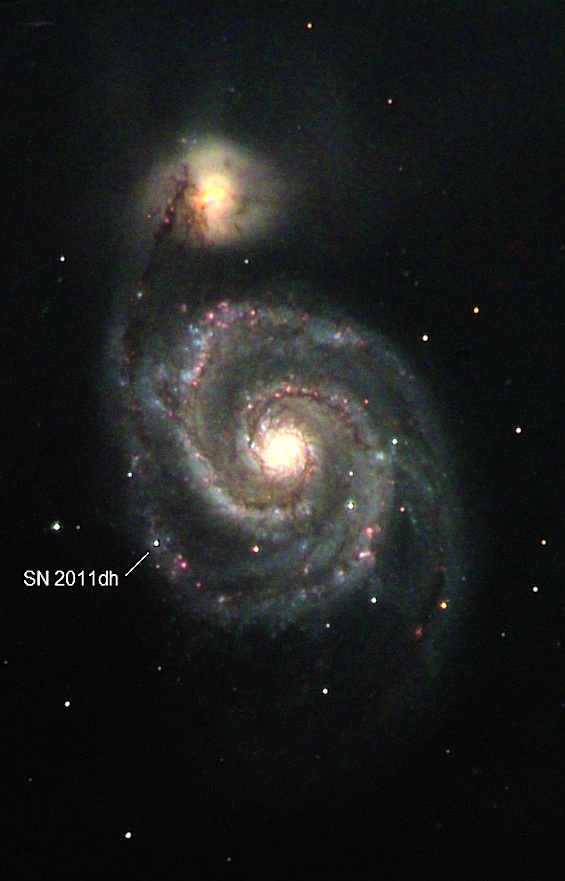
This rare nearby supernova in the galaxy M51 was discovered a few days ago by the group I belong to, The Palomar Transient Factory, and others. Notice the galaxy is still there. We’re studying it intensely now. Image credit: Chip Gentry / Austin Astronomical Society.
And if the star giving life to Romulus went supernova, what good is absorbing the supernova into a black hole going to do? So what if they don’t burn in the supernova, now they are going to freeze without a star! So Spock wasn’t exactly saving their planet – more like giving them a few days to get off it before the atmosphere freezes out and it becomes an ice ball.
And another thing, if your sun goes supernova, it isn’t “unthinkable” that the planet would be destroyed. It’s quite thinkable! Well, life would be destroyed. If you think the deadly wrath of a tornado can induce awe, contemplate a supernova.
I often think of that when I’m at the telescope – interesting new supernova for me – death for billions.
Technically, the body of the planet (if rocky) could survive in some form, albeit stripped of its atmosphere and pesky life forms. While theoretically a planet could present a big enough target to absorb enough energy from a supernova to disintegrate it (I actually calculated this), in reality it probably wouldn’t happen. The blast wave of the supernova would mostly take the path of least resistance and just blow around the planet. But those are details. This looks cool, so I’m actually glad they did it this way:
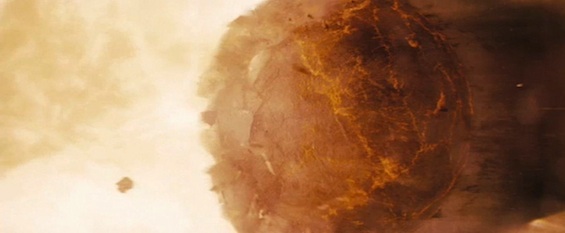
But how quick would Spock have to be with his fastest ship?
For a star to go supernova, it would have to be at least 8 times the mass of the sun. So Romulus would have to be farther away from its star than the Earth is to the Sun to be habitable. Let’s say it is 10 times the Earth-Sun distance (basically where Saturn is). That would be 1.5 billion kilometers. The material in a supernova is flying out at about 10,000 km/s. So it would hit the planet 150,000 seconds, or 42 hours after the star exploded. Spock is a character who likes to calculate random shit for no better reason than just to show off and infuriate humans. And he flubbed this basic arithmetic with billions of lives on the line? He was “en route when the unthinkable happened!?” “Oops, sorry Romulans, I was on the way, but I guess I miscalculated how much time your entire species, every species on the planet, and even those Bat-faced Remans had left.” “Unthinkable,” my ass! If I gave this homework problem to my students, and they wrote “unthinkable” as the answer, I’d not only fail them, I’d call their parents to tell them that they should never have reproduced. Abrams-Spock, your ignorance is so vast that it has become genocidal. You are a genocidal moron! Billions of Romulans are now vapor because you ditched the Vulcan Science Academy to help Kirk chase tail around the galaxy.
IT GETS WORSE
Ok, in geek-speak, if you treat only the film as cononical, then that’s the way it went down. But there was a prequel comic, Countdown, which the writers of the film, Orci and Kurtzman, had some involvement in. If you believe the comic, then the star that exploded was the Hobus star, and it wasn’t even the home star of Romulus! Turns out, this supernova just expanded and expanded, eating star systems all around the galaxy. This is ludicrous.
Aside from the energetics, which don’t work, there is the speed problem. At a typical velocity for the stuff ejected from the supernova (the technical term is ejecta) of 10,000 km/s, it would take a century to travel the typical distance to the nearest star (about 3 lightyears). Even if this material were going as fast as has ever been seen in a supernova, about a tenth the speed of light, and the star that exploded was in the next star system over from Romulus, the blast would have taken more than 30 years to reach Romulus. So well before the first season of ST:TNG the Romulans would have been furrowing their furrowed brows off. Even if the supernova ejecta were traveling at the speed of light (an impossibility), it would have taken three years to threaten Romulus. So in this scenario, Spock isn’t stupid, he’s just lazy.
WHAT THEY SHOULD HAVE DONE
If they wanted to preserve the “threatening the galaxy” angle, they should have invented some new kind of space disturbance, rather than relying on a supernova, whose properties are known. But one thing I don’t like about previous Trek incarnations is the random made-up technobabble of the week. There is a certain amount of verisimilitude you get by invoking an actual supernova. But you can’t just use the word without the meaning. So keep it a supernova. In that case, Spock should have said: “129 years from now, a star will explode and threaten to destroy the galaxy Romulus. The star went supernova, consuming everything in its path. I promised the Romulans that I would save their planet. We outfitted our fastest ship. Using red matter, I would create a black hole, which would absorb the exploding star. I was en route when the unthinkable happened. [But I was too late.] The supernova destroyed Romulus.”
RED MATTER
Surprisingly enough, I don’t hate Red Matter, although the way it was dealt with could have been handled much better. The script called for (1) something to stop a supernova, (2) the creation of a black hole / wormhole to make time travel possible, (3) something that would destroy Vulcan, (4) something to create a black hole at the end of the film. So why not invent a MacGuffin that can do all that? Sounds crazy, but so does Dark Matter – invisible matter that only interacts gravitationally, and we think that stuff is the predominant form of matter in the universe. Baryonic matter, the stuff we (and stars) are made of, is the weird stuff as far as the universe is concerned.
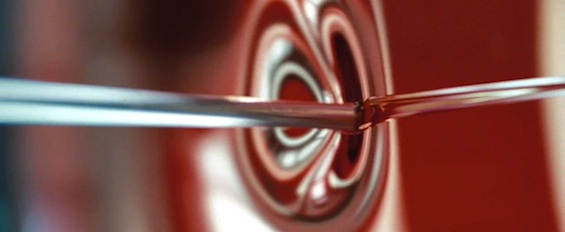
The problem with Red Matter is that it is now the ultimate weapon in the Star Trek universe. A syringe of it can destroy a planet – or even a star or supernova! Why screw around with photon torpedoes when you can have Red Matter torpedoes? And shields would be pointless. I suppose you could say that all the Red Matter in the Trek universe was destroyed at the end of the film. Well, ok, then why was Spock hauling around all the red matter in the universe! He only needed a syringe! Spock is like a redneck hauling around a pickup truck full of dynamite. Or even worse… antimatter. That’s dangerous! What if he crashed? Not only would he become a black hole, they’d have no more chances to fix this or any other supernova.

And there is another thing about carrying around a giant red orb that can be used as a weapon. A syringe you can hide. But a giant red orb? When Nero and crew captured Spock’s vessel, it sure didn’t take them long to find the ultimate secret weapon in Spock’s ship. “Henchman – search the ship for… whoa! What’s that giant red thing?” Nero then uses this to destroy Vulcan. So dumbass redneck Spock is responsible for destroying not only all Romulans, but all Vulcans too! I don’t think even villains in the Star Trek universe have wiped out two species, including their own.
BLACK HOLES
Black holes are called that because nothing can escape, not even light. But in the Star Trek universe really good characters can escape from them, but bad guys sometimes get crushed. On other occasions they make you go back in time. Maybe they should call them Plot Holes. Technically a supernova can create a black hole, so they didn’t necessarily need Red Matter to do it. But there are a few things you get by invoking Red Matter – a black hole sometimes can’t stop a supernova, but maybe a Red Matter enhanced one can. And maybe Red Matter can turn an our-universe black hole into a Trek-universe black hole. I’m actually fine with Red Matter time traveling black holes.
SATURN
Near the end of the film, our heroes warp right into the atmosphere of Titan and hide there. Love it! Seeing the Enterprise rise out of a real astronomical body is one of the most amazing images in all of Star Trek history.

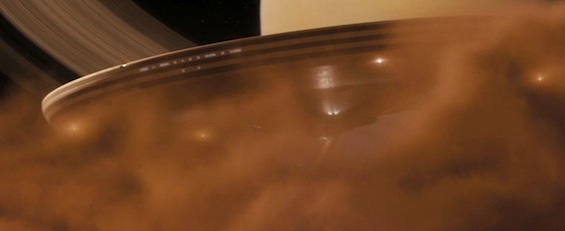
The problem comes when Chekov opens his damn fool mouth. First he seems uncertain about which moon of Saturn to hide in. Titan is the only real choice – it is by far the largest and the only one with an atmosphere! But then he says, “The magnetic distortion from the planet’s rings will make us invisible to Nero’s sensors.” Ok, Saturn does have a magnetic field, so that’s almost plausible. But it’s weaker than the Earth’s, and even an iPhone can handle the Earth’s magnetic field. I bet a 24th century spaceship would have that sorted right out. But we’ll let that slide – it would have been great if they had stopped there. I wouldn’t have written a thing except how cool that sequence is.
The problem is the rings have nothing to do with the magnetic field! No distortion! They are just lumps of ice and rock. What really bugs me is that, according to the credits, they had Carolyn Porco as a science consultant, maybe the best expert on Saturn and its moons mankind has ever had. She’s responsible for the camera on a real spaceship orbiting Saturn right now, Cassinni, and they can’t be bothered to either ask her or listen to her on this?
Between the non-supernova and the ring magnetic field, I can only describe this as Sarah Palin writing – they want the cachet of fancy words, but they don’t know what they mean so they just make a word salad. Words have meaning! Even astronomical ones! Or maybe they do know what the words mean and are ignoring it, banking on the stupidity of their audience. That would be worse.
Ok, rant over.
I really did enjoy the movie. I get passionate about Trek because I care. The story, characters, actors, effects, music, and direction were great. These could have all stayed the same with just a nonsense pass by an astronomer over the dialog. A consultation with a real astronomer, who thinks about space all day long, might have even improved the film in other ways. I can think of a million background settings and insane astronomical objects I’d love to see the Enterprise visit, even in passing.
Consider this – I grew up as a lanky logic-minded misfit. I was inspired to be a scientist, partially because of Spock. But now I have to face the fact that I’m smarter than Spock. At least this one. That makes me sad. It doesn’t have to be this way! The writers are experts at drama, characters, and comedy. Get a science expert for the science.
And you might say, “So what if you piss off a bunch of braniac astronomers.” It is true, there aren’t many of us out there. But we have a disproportionate effect on culture. How many times have you seen Hubble images, or other astronomical discoveries in the news? And just think about how many astronomy TV shows there are out there. On mine this week, we cover replicators from Star Trek! (more HERE) We can’t afford to have Star Trek be a laughing stock of the cognoscenti. And Trek-fans themselves tend to be pretty educated when it comes to science.
I can’t wait for the next Trek. But I hope they really do go where no one has gone before. I want to see strange new worlds and new civilizations. And I hope the astronomy is bad-ass.
-Andy Howell aka Copernicus
